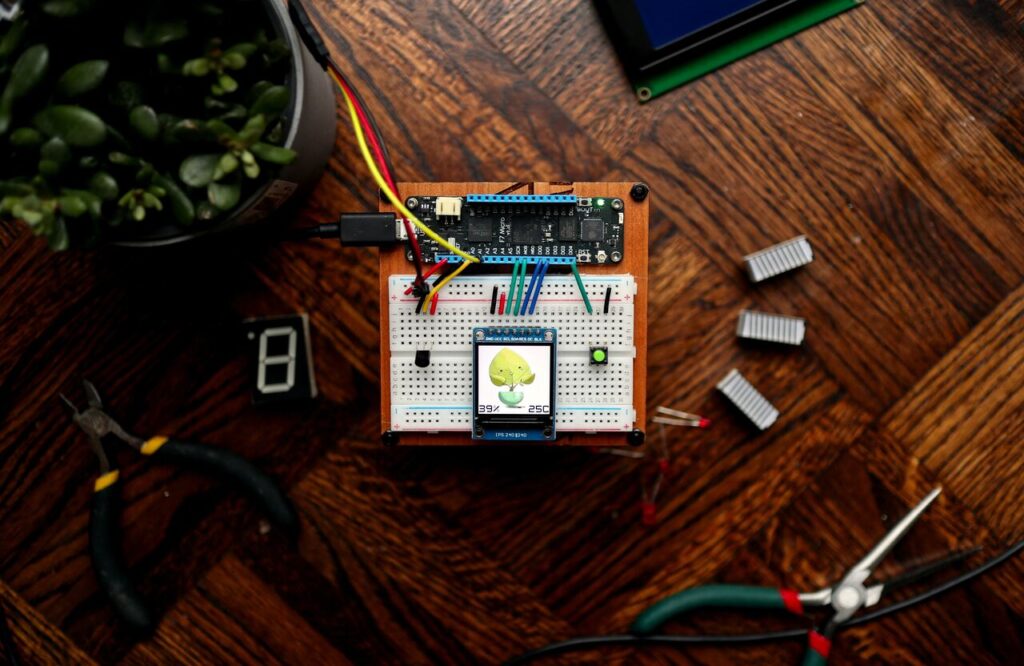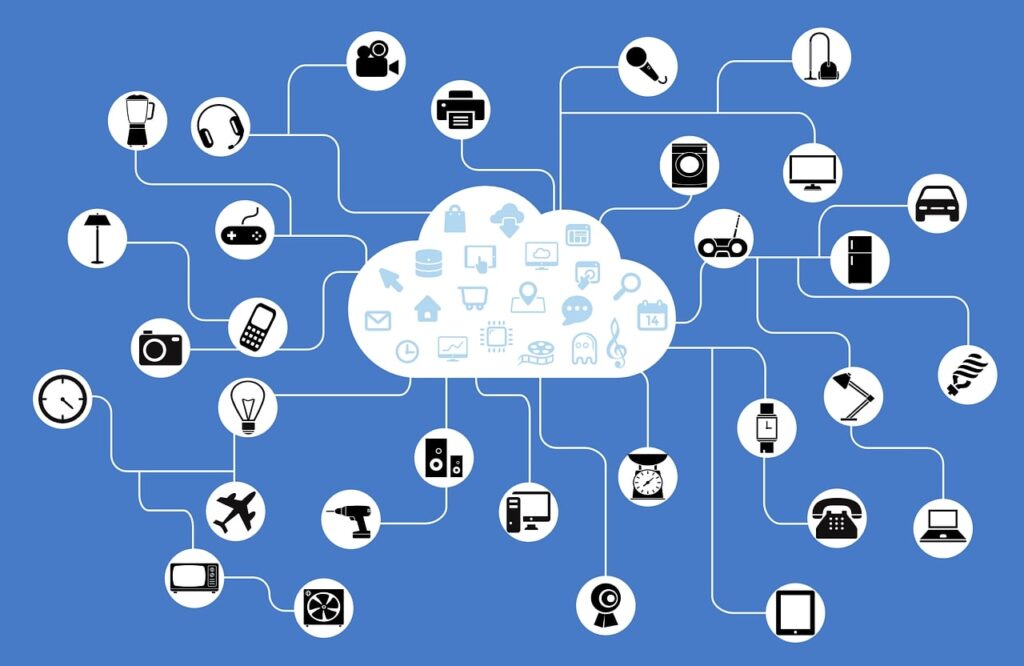
Have you ever heard of the Internet of Things, or IoT for short?
It’s a fascinating concept that describes a vast network of physical objects, devices, and even buildings that are all connected to the internet.
Okay, picture this – you wake up in the morning and your alarm clock is buzzing. But instead of hitting the snooze button, you reach over and tell your smart speaker to turn on the lights, start the coffee maker, and play your favorite podcast. And all of this happens without you even getting out of bed.
Everything from your smartphone to your refrigerator to your car can now be connected to the internet and can communicate with each other. This opens up a world of possibilities for automation, efficiency, and innovation.
Welcome to the world of the Internet of Things, or IoT for short. It’s a fancy term for all the cool gadgets and devices that can talk to each other and share information, thanks to the power of the internet.
What is IoT ?

The Internet of Things, or IoT for short, refers to the idea of connecting everyday devices and machines to the internet so that they can share data and communicate with each other.
But why on earth would you want that, you ask? Well, imagine this scenario: you wake up late one morning and rush to get ready for work. You’re about to leave the house when you suddenly realize you forgot to turn off the stove.
Instead of panicking and running back inside, you simply take out your smartphone and tell your smart home system to turn it off for you. Crisis averted!
“The collective network of connected devices and the technology that facilitates communication between devices and the cloud, as well as between the devices themselves.”
This is the magic of Internet of Things – by connecting devices and machines to the internet, we can make our lives more convenient and efficient. From smart thermostats that adjust the temperature based on your habits, to wearable healthcare devices that track your fitness and health, the possibilities are endless.
It’s estimated that by 2025, there will be over 75 billion IoT devices in use globally.
With great power comes great responsibility… Of course, with all this connectivity comes some challenges, like security and privacy concerns. But with the right precautions in place, IoT has the potential to change the world as we know it.
But how does Internet of Things works ?
How IoT works ?

Internet of Things is all about connecting devices to the internet so that they can share data and communicate with each other. This requires three key components: Device, Network and Cloud.
Think about your smartphone – it’s a device that can connect to the internet, right?
Well, IoT takes that concept a step further and connects all sorts of devices – from your smartwatch and your coffee maker to your car and even industrial machines – to the internet.
Devices collect data – let’s say you have a smart thermostat that’s keeping track of the temperature in your home. It collects that data and sends it somewhere.
The data is sent to the cloud – the cloud is basically a big server somewhere that stores all the data from lots of different devices. So, your thermostat sends the temperature data to the cloud, where it’s stored.
The cloud processes the data – the cloud doesn’t just store the data, it also looks at it and tries to make sense of it. So, it might notice that the temperature in your home is getting too high, and send a message to your air conditioner to turn on.
Devices receive commands – based on the data that the cloud has analyzed, it might send a message back to your thermostat or your air conditioner, telling them to do something. So, your air conditioner might turn on, and your thermostat might adjust the temperature setting.
There are a lot of other details and complexities involved in Internet of Things, but that’s the basic idea. By connecting all these devices to the internet and analyzing the data they collect, we can create a more efficient and interconnected world.
The world of Internet of Things is vast and fascinating, and it’s no wonder that it can be classified in so many different ways! Let me take you on a journey of the different classifications that exist in this exciting world.
Classification of IoT

Not all IoT devices are the same – they can be classified in different ways based on how they work and what they do.
One way to classify IoT devices is based on the type of device.
For example, you might have a wearable healthcare device like a fitness tracker, or a smart home device like a thermostat or a security camera.
- Wearables: Fitbit, Apple Watch, smart glasses
- Smart home devices: Nest thermostat, Amazon Echo, Philips Hue lights
- Industrial IoT devices: sensors in manufacturing plants, drones for inspections
- Medical devices: glucose monitoring systems, connected inhalers
- Others: connected cars, smart locks, pet trackers
There are also industrial IoT devices used in factories and other types of businesses, and medical devices that help doctors monitor patients.
Another way to classify IoT devices is based on how they connect to the internet.
Some devices use Wi-Fi to connect, while others use Bluetooth, cellular networks, or other types of wireless technology.
- Wi-Fi: Nest thermostat, Amazon Echo
- Bluetooth: Fitbit, smart locks
- Cellular: connected cars, asset trackers
- Zigbee: Philips Hue lights, smart home sensors
IoT devices can also be classified based on what they do.
For example, some devices are used for sensing – they can measure things like temperature, humidity, and air quality. Other devices are used for actuation – they can control things like lights, locks, and appliances. Some devices are used for communication, so they can send and receive messages from other devices.
- Sensing: temperature sensors, humidity sensors
- Actuation: smart locks, smart lights
- Control: smart thermostats, sprinkler systems
- Communication: Amazon Echo, video conferencing systems
IoT devices can also be classified based on the applications they’re used for.
For example, some devices are used for home automation – they can control things like your lights, thermostat, and security system. Others are used for healthcare, like devices that monitor patients’ vital signs or help them manage their medications.
- Home automation: smart thermostats, Philips Hue lights
- Healthcare: glucose monitoring systems, connected inhalers
- Smart cities: traffic monitoring systems, parking sensors
- Agriculture: soil moisture sensors, automated irrigation systems
- Transportation: connected cars, fleet management systems
Finally, IoT devices can be classified based on how they’re powered.
Some devices run on batteries, while others are wired directly into an electrical outlet. And some devices use energy harvesting, which means they generate power from their environment – for example, a sensor that’s powered by solar energy.
- Battery-powered: smart locks, wearables
- Wired: Nest thermostat, Amazon Echo
- Energy harvesting: soil moisture sensors, solar-powered sensors
So you see, there are lots of different ways to classify IoT devices. I hope now you understand each classification of IoT better…
With a little bit of knowledge and know-how, anyone can get started with Internet of Things and start reaping the benefits. If you’re interested in getting started with Internet of Things , here are some steps you can take…
7 Steps to Starting Your IoT Journey
- Learn the basics: Start by understanding what IoT is and how it works. There are many online resources available that can help you learn the fundamentals of IoT.
- Choose a platform: There are several IoT platforms available, such as Arduino, Raspberry Pi, and Intel Edison. Choose a platform based on your needs and skill level.
- Get the hardware: Once you’ve chosen a platform, you’ll need to get the necessary hardware. This may include sensors, actuators, microcontrollers, and other components depending on your project.
- Choose a programming language: Depending on the platform you’ve chosen, you may need to learn a programming language. Common languages used in IoT projects include C/C++, Python, and JavaScript.
- Start building: With the basics covered, you’re ready to start building your IoT project. Start with a simple project and work your way up to more complex projects as you gain experience.
- Test and iterate: Test your project to ensure it’s working as expected. If there are issues, iterate and refine your project until you achieve the desired results.
- Deploy and monitor: Once your project is complete, deploy it and monitor its performance. This will help you identify any issues and make improvements over time.
So, there you have it! We’ve covered what the Internet of Things is, how it works, and how to get started with it. We also looked at some common classifications of Internet of Things devices based on different parameters.
In conclusion, Internet of Things is an exciting technology that has the potential to change the way we live and work. By connecting everyday devices to the internet, we can collect and analyze data to make better decisions and automate tasks.
Whether you’re interested in home automation, industrial IoT, or any other application, the first step is to understand the basics and start exploring. So why not give it a try? Who knows, you might just discover the next big thing in IoT!